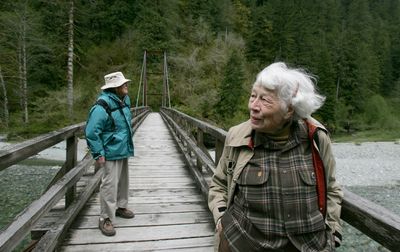Park’s parents still protective
New project would expand North Cascades wilderness areas

BAKER RIVER TRAIL, Wash. – As sometimes happens with parents, their work is never done even though their offspring is 40 years old.
So it is for Polly Dyer and Patrick Goldsworthy, two of the parents of North Cascades National Park, who helped push for its original designation.
Now as the park turns 40, the two have kicked off a campaign with the Mountaineers, North Cascades Conservation Council and other conservation groups to finish their work, and expand the park to protect scenic landscapes not included in the original designation.
A scarf on her head and purse slung over her shoulder, Dyer, 89, last week set off down the Baker River Trail, a classic case in point. The trail and lands surrounding it are today owned by the U.S. Forest Service and do not have permanent protection, despite the old-growth cedars some 500 years old and others even more venerable keeping counsel by the green slide of the Baker River.
Using two hands to lift a leg over a fallen log, Dyer has never lost her passion for hiking or conservation. Goldsworthy, at 90, is just as committed. For many summers, he hiked in the North Cascades with his buddies, including the late hiking and trail-guide guru Harvey Manning. “I wasn’t into just mileage, I wanted to know the country,” Goldsworthy said. “We went every place you could think of to get to know the Cascades.”
Goldsworthy fell in love with the North Cascades when he moved to Seattle from California around 1950. “I had no idea there was such a wonderful place. I fell in love with the forested mountains,” Goldsworthy said. “I thought: ‘We just have to do something to protect this.’ ”
Dubbed the American Alps Legacy Project, the effort to expand the park is still in development. Maps of proposed areas for protection have been prepared, and now the conservation council and other advocates will begin reaching out to the public to see how the proposal should take final shape before it goes to Congress.
The conservation council kicked off the American Alps Legacy Project last week at the Mountaineers Club in Seattle. The project includes only federal lands; no private lands would be affected. While they are federally owned, because they are outside the park, those lands could still be roaded, logged or mined, and their rivers dammed.
The proposal will be released in the fall.
Lands sought for protection include lowland forests and scenic areas along the North Cascades Highway between Newhalem and Washington Pass. Designation of new wilderness areas on federal lands adjacent to the North Cascades National Park also will be considered.
A new visitors center on the east side of the park is under discussion, as is construction of new trails, to build recreation opportunities that could help boost local economies in the gateway communities in the Methow and Skagit valleys.
The conservation vision extends to about 343,000 acres of land. The precise amount is still under discussion as the boundaries of the proposal are drawn. The park includes 684,000 acres today.
“It’s time to finish the work begun in 1968,” said Jim Davis, executive director for the North Cascades Conservation Council, formed as a nonprofit in 1957 to focus on creating the park.
Dyer and Goldsworthy, both founding board members, remember that even back then they knew lands were being left out that should have been protected. Those lands were left outside the park boundaries as a political necessity because of powerful logging interests, Goldsworthy said. Pushing for more might have scuttled the whole effort.
Awareness of the importance of the forested lowlands for protection of water quality and habitat, as well as access for a longer recreation season, grew over the next 40 years, making now the time to push for protection, Davis said.
In Goldsworthy and Dyer, the expansion project has tenacious backers and lifelong evangelists for wild lands. As a former Girl Scout leader in Auburn, Dyer led her 9-year-old charges into the woods for weeklong camping trips.
“I wasn’t about crafts,” Dyer said. “Conservation. That is what I wanted them to learn.”